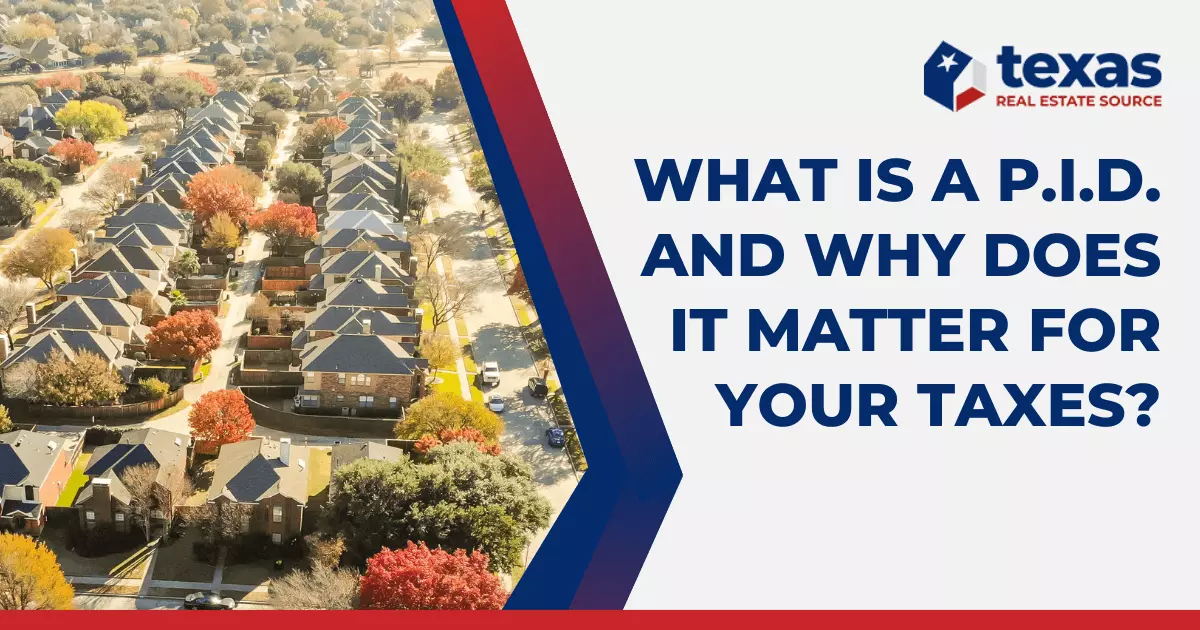 It's no secret that calculating and paying real estate taxes can be complicated. This is particularly true of property taxes in Texas, with its many different taxing entities and special districts. One such special district is the Public Improvement District, or PID.
It's no secret that calculating and paying real estate taxes can be complicated. This is particularly true of property taxes in Texas, with its many different taxing entities and special districts. One such special district is the Public Improvement District, or PID.
Understanding PIDs: Enhancing Communities in Texas
 Homebuyers often come across various abbreviations on real estate documents. Tax statements, in particular, can be complex, with classification shorthand and acronyms like CADs, MUDs, and ISDs. But one abbreviation, PID, can confuse taxpayers and make them wonder what it means.
Homebuyers often come across various abbreviations on real estate documents. Tax statements, in particular, can be complex, with classification shorthand and acronyms like CADs, MUDs, and ISDs. But one abbreviation, PID, can confuse taxpayers and make them wonder what it means.
In Texas, PID stands for Public Improvement District. These districts are authorized by state statute and enable cities and counties to levy assessments on properties within their district. The revenue generated from these assessments is used to fund specific improvements that benefit the properties in the district. These improvements can include road construction, water distribution systems, wastewater collection, landscaping, city parks, recreational opportunities, and more. PID assessments are typically based on the size of the property.
PIDs vs. MUDs: What's the Difference?
Public Improvement Districts (PIDs) and Municipal Utility Districts (MUDs) have some similarities, but they serve different purposes. Both have local taxing authority under the Texas tax code, but the key difference lies in the intended use of the collected taxes.
MUDs are created to finance, build, and maintain infrastructure and services related to water, sewer, and drainage in areas that are not managed by local governments. These districts fund utilities in residential communities outside the limits of a city's public services.
On the other hand, PIDs can be used for a variety of community improvements, including parks, landscaping, and non-utility enhancements. While MUD taxes are primarily for water and sewer, PID revenue is allocated to a broader range of enhancements.
PIDs vs. PUDs: Clearing Up the Confusion
Confusion can arise between PIDs and PUDs (Planned Unit Developments) or even homeowners' associations (HOAs). However, they are distinct entities.
PUDs are special zoning designations that offer greater flexibility in land use, often granted to existing subdivisions. They may include commercial properties and residential areas. PUDs always have HOAs, but not all HOAs are part of a PUD.
PIDs, as previously mentioned, are special taxing entities created and controlled by cities or counties. They levy taxes to fund property enhancements, while HOAs are usually managed by homeowners and charge dues to support specific community services.
PIDs vs. TIFs: Understanding the Difference
PIDs and TIFs (Tax Increment Financing Districts) are both special districts related to funding property improvements, but they have different applications.
Tax Increment Financing Districts aim to increase real estate values and generate more property tax revenue. In contrast, PIDs levy additional payments on top of property taxes to fund specific improvements.
Understanding the PID Number in Real Estate
The acronym PID can also refer to a parcel's Property Identification Number. This number uniquely identifies a property's location and is unrelated to Public Improvement Districts.
Homeowners can find their PID number on their annual property tax statement, typically located near the property owner's name. Other names for this number include APN (assessor’s parcel number), AIN (assessor’s identification number), PIN (property identification number), property account number, tax account number, and Sidwell number.
How to Determine if You're in a Public Improvement District
Before closing, sellers and their agents are required by law to disclose the existence of Public Improvement Districts in Texas communities to potential buyers. This information is often included in the property listing description.
How Long Do PID Taxes Last?
 Public Improvement District assessments have a finite duration. These taxes are spread out over a 20- to 40-year period, ending once the property's fees have been paid in full. Homeowners can also choose to pay off the total assessed amount in a single lump sum.
Public Improvement District assessments have a finite duration. These taxes are spread out over a 20- to 40-year period, ending once the property's fees have been paid in full. Homeowners can also choose to pay off the total assessed amount in a single lump sum.
Are PID Assessments Included in Property Taxes?
Public Improvement District assessments are usually billed and collected by county tax offices along with standard property taxes. However, PIDs are not included in property tax amounts. They are paid in addition to any assessed real estate taxes and can be paid separately from property tax bills.
Where Can You Find PIDs in Texas?
 Almost every large city in Texas has Public Improvement Districts, although some may not apply to the average homebuyer. PIDs can cover different property types and have specific purposes.
Almost every large city in Texas has Public Improvement Districts, although some may not apply to the average homebuyer. PIDs can cover different property types and have specific purposes.
For example, the city of Fort Worth has several PIDs across various parts of the city, each with its own focus. Some are limited to residential properties, while others apply only to commercial properties or hotel properties of a certain size. Likewise, the city of Austin supports different types of PIDs for infrastructure development and commercial business districts.
Understanding PID Taxes in Texas
Public Improvement Districts in Texas allow cities to fund residential development and enhancements. Homebuyers within a defined PID pay a fixed assessment amount on top of their property taxes. The billing and collection of PID taxes are managed by each county's tax collector. PID fees can be paid annually or in a lump sum. These funds are used to improve roads, water and sewer lines, drainage, landscaping, irrigation, and other community upgrades.
Unlike traditional annual property taxes, PID assessments expire once paid in full. PID taxes are calculated based on the size of the lot, rather than the appraised value.
Now that you know what PIDs are and what they entail, you can better understand your property's involvement in a Public Improvement District. Sellers and their agents are required to disclose any PIDs before closing, and tax statements typically indicate the presence of special districts. Additionally, taxpayers can search for special purpose districts in their county through the Texas Comptroller's website.











